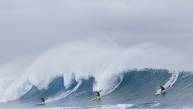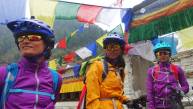This week in Women in the Ocean, we sat down with surfer and co-founder of Textured Waves Chelsea Woody. Textured Waves is a surf collective aiming to create a surf community for women of color and underrepresented demographics. Bethany Mollenkof + Seea photo.
There's this special thing called "sea-sterhood." Chelsea Woody, Danielle Black Lyons, Gigi Lucas, and Martina Duran first coined the term on a surf meetup together to describe their sisterly camaraderie. Despite all living thousands of miles apart—San Diego, Jacksonville Beach, Santa Cruz, and Honolulu,—these complete strangers all bonded over being African American female surfers. For each of them, it was rare to spot another Black female surfer in the lineup when they first started surfing. Thankfully, this is slowly changing.
Tired of feeling like a unicorn, these women sought each other out by means of social media, and became lifelong friends when they met up for a surf vacation. They bonded over their shared experiences and the desire to share their love for the ocean with more people like themselves. Inspired by their newfound community, the women found themselves eager to do more. Together they launched the surf collective Textured Waves in 2019, aiming to create a surf community for women of color and underrepresented demographics through storytelling, events, and sisterhood.
RELATED: 'Pedal Through' Highlights Black Joy and Healing on Two Wheels
This past June, they premiered their most ambitious project yet, a short film called Sea Us Now. The film takes the audience back to the 1950s; a period hallmarked as the “Golden Age” of surfing. For many older surfers, these were the good ol' days. It was a time when vintage station wagons with surfboards lined the beaches in Malibu, California. Women rejected the domestic norms of the 40s, and instead gracefully surfed on the waves, ultimately inspiring the iconic movie Gidget. The beaches were less crowded, and when the surf was firing no one seemed to care about ditching work a little early to catch a good swell. From a quick glance, it was quite the time to be a surfer, but this romanticized view doesn’t tell the full story.
When you take off the rose-tinted glasses, you start to notice the less glamorous aspects of the ‘50s, like segregation. During this period, racial discrimination barred Black Americans from congregating in predominantly White spaces. These restrictions applied to many public beaches and swimming pools, and as a result, many Black communities struggled to develop a relationship with the ocean. Sea Us Now presents a different reality, one that asks what would have happened had the ocean been accessible to everyone. It’s a story that not only seeks to heal the wounds from the past, but inspire future generations to redefine their narrative moving forward. After all, the ocean is for everyone.
We sat down with Textured Waves Co-founder Chelsea Woody to hear more about the film, and the many ways Textured Waves hopes to make surfing a sport for all shades of women.
Can you start by sharing a little about yourself and how you became involved with Textured Waves?
Chelsea Woody: I live in Northern California and regularly surf throughout the area. My involvement with Textured Waves started by connecting with these ladies online. It's pretty rare to see other African American female surfers, and I think community is something that we naturally craved. Originally, the other Textured Waves co-founders and I had this idea to meet in person and go surfing together. Over time we realized the need to share our story because we didn't see the representation of ourselves—African American females specifically—in most surf media. All of us started surfing at a later stage in our lives, and our hope with this collective is to encourage younger folks—especially young black girls—to get into surfing.
Are you hoping to create role models for the next generation of surfers?
CW: Yes. I'd say that's something that none of us had when we were younger. Even though we're not professional surfers, you can't discount what imagery provides for the next generation. I think had we all seen content like the kind on Textured Waves; there's a chance the other gals and I would have pursued the sport earlier. Maybe not, but it would have been nice to have the representation.
Creating relatable and strong role models is one way to encourage change and inclusivity, the Collective argues. Nick Lavecchia + Seea photo.
When you were young, did you find surfing to be intimidating?
CW: I grew up in Washington state, and we didn't live near the coast, so that was a factor for sure. When I was younger, my role models were women that I saw often on television like track, basketball, and gymnastics athletes like Dominique Dawes. I was really inspired by these prominent Black women, who honestly resembled my mother. So I don't think surfing was even on my radar until Blue Crush came out. I remember watching it in theaters while I was in high school and thinking, "I'd love to do that." But whenever I was in the position to try it, I couldn't bring myself to get into the ocean. Whether it was this ingrained fear of the sea or just not seeing images of folks that looked like me, I think it didn’t feel approachable.
What eventually led you to pick up the sport?
CW: I started surfing about five years ago on a trip my husband and I took around the world. It was a big adventure, and we saw 17 different countries, and had so many new experiences. On that trip, I decided that I wanted to learn and started surfing in Indonesia. We spent a month on the islandLombok and taught ourselves how to surf. When we returned to the States from traveling, we were so hooked on the sport that we packed up our things and moved to Northern California.
Is it true that you initially connected with the other women from textured waves by social media?
CW: Yes, and I think that's the beauty of it. The reality is that there are not many African American female surfers in the lineup. We had to seek each other out, and we're spread out across the states in Florida, Hawaii, and California. I think that's an exciting aspect about Textured Waves because we can tell this story from different vantage points. Surfing is not the same in each of these places, and we came to the sport for various reasons. It also allows us to tell a more inclusive story of what it's like to be an African American female surfer.
Left To Right | Danielle Black Lyons - Martina Duran - Gigi Lucas - Chelsea Woody| Bethany Mollenkof + Seea photo.
Why do you think the idea of community is vital to sports like surfing?
CW: I think it's powerful because often you can feel alone. It's nice to know that there are other women out there like you. Media has created a very narrow visual of who a surfer is, community allows us to redefine that visual and tell different stories that may not be told in the mainstream. It also expands people's minds on both sides of the spectrum and gives them an alternative view of what it means to be a surfer. As African American women, there are societal constraints that dictate the way we are “supposed” to look, act, or dress, and I think creating a surf community can disrupt those notions of what a woman should be.
Plus, there's something about the friendships you make in the water. We call it "sea-sterhood," and there's an unexplainable kinship that occurs when you share your love of riding waves with other women. I think it's worth addressing that weren't not trying to say, "we'll only surf with other women who look like us." Instead, we've created Textured Waves so no one has to feel like a unicorn in the water, wondering if there's anyone out there that can relate to them. Our message is that you're not alone.
Do you think there's something special about the female connection to the ocean and surfing?
CW: I think surfing resonates with women because when you go into the ocean, you can't hide from your natural self. Your makeup runs off, the product washes out of your hair, and it brings you back to this natural state. Many of my girlfriends including myself find it empowering and freeing.
Why do you think groups like Textured Waves are essential for the African American community?
CW: A big part of this collective is to get back to our roots. There's this perception that Black folks aren't water people, but our connection to the ocean is actually in our history. Back in Africa, we were water people swimming and fishing in coastal towns. We’ve always had this beautiful relationship with the water.
When you dive into the time of segregation and the Jim Crow era, there's this troubling history of African Americans not having equal access to the ocean. Would you say your film Sea Us Now is trying to mend old wounds?
CW: Yes. I think we're trying to reclaim these spaces. Again there's this perception that Black folks chose not to go to the beach during that era, which isn't true. There was Black beach culture, but it was segregated, so it wasn't really documented in the way it should have been. We wanted to reimagine what that period would be like had everyone had equal access to the coastline. I imagine Black folks would have had a more developed surf culture, and Black women would have been part of that.
So our idea with the film was to marry Black beach culture with vintage surf and reimagine these spaces with Black Joy. Ultimately, we’re asking the viewer why they haven't seen images of Black women in these American spaces. Hopefully, that inspires deeper contemplation about all imagery in outdoor media.
The film was a collaboration with the swimwear brand Seea. How did they help with bringing the project to life?
CW: Before Seea, the surf industry wasn’t really paying attention to Textured Waves. Their team genuinely believed in our vision.It was a beautiful collaboration, and they wanted this story to be told through our lens. I couldn't imagine a different brand fitting the nostalgic vibe we were trying to recreate.
I developed the film idea a few years ago and didn't think anything would come from it. But in November 2019, Seea's owner Amanda Chinchelli reached out and wanted to collaborate with Textured Waves. It was just wild because we didn't really have many followers at the time, and we pitched her the idea for the film, and she believed in our mission. It was an organic relationship, and we filmed right before the pandemic lockdown. Looking back, it's crazy because this project was already in motion way before the Black Lives Matter momentum this summer, and it just happened to be an appropriate and timely message to examine our country’s history.
Their short film Sea Us Now was inspired by African American beach culture and vintage surf culture, and brought to life through a collaboration with the brand Seea. Bethany Mollenkof + Seea photo.
Who did you work with on the creative side of things?
CW: We worked with an African American female filmmaker named Bethany Mollenkof. We wanted to be seen through the lens of a Black woman. I don't think there's been a surf film directed by an African American woman, so that's a huge step forward for our community.
I credit Bethany because despite not being a surfer she was able to bridge these ideas I had beautifully.
On top of creating content, Textured Waves seems heavily involved with community outreach. What are some ways you hope to grow the Black surfing community?
CW: We don't tout ourselves as surf instructors, so we want to connect our audience with people who can elevate their surfing experience. Our goal is to work with grassroots organizations that are getting more diverse individuals in the water. We have a community page where we promote organizations we have vetted, and personally love what they're doing. We feel that there isn't just one solution to changing access and surf culture. It has to be approached from all different angles. The imagery has to change, the accessibility, and it also has to change within the industry as well, you know. It doesn't just come down to marketing campaigns, but the folks working in the industry making decisions have to change.
There's no easy band-aid. It's going to take generations of integration and change.
The collective hopes to inspire a new generation of surfers that reflects the diverse water they walk on. Nick Lavecchia + Seea photo.
Totally. Change takes time, and hopefully, we'll start to see a more diverse lineup in entities like the WSL.
CW: Right. We've realized changes on a highly competitive level like the WSL don't happen unless there's more integration in all aspects of the sport, like surfing for leisure. You need to grow the group of people who will get their children interested in the sport, so eventually, one of those kids gets inspired to work toward something like competing on the WSL.
Does the collective also host events?
CW: We would have done more events had COVID not happened, but we usually love to do round table discussions about our films. During the pandemic I think it's a perfect way to connect with our local communities and have in-depth conversations. Retreats are something that we're excited to do in the future as well.



__video_thumb.jpg)









__video_thumb.jpg)

__video_thumb.jpeg)







Sean T Davis
December 9th, 2020
Impressive!Thanks for the post. Usually I never comment on blogs but your article is so convincing that I never stop myself to say something about it. You’re doing a great job Man,Keep it up.
very interesting , good job and thanks for sharing such a good blog. I am glad to share this with you Using wireless microphone
joanmelda
December 9th, 2020
There are many information technology research writing services and Information Technology Essay Writing Services to choose from for those stuck with their information technology coursework writing services and information technology dissertation writing services.
https://researchpapers247.com/information-technology-essay-writing-services/